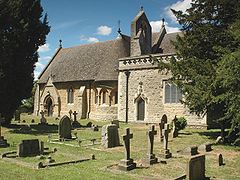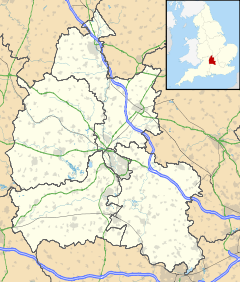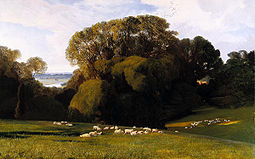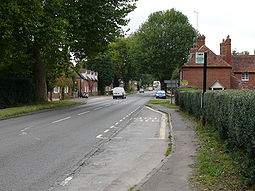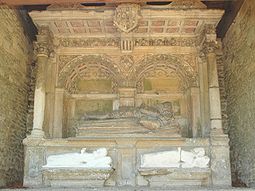- Nuneham Courtenay
-
Coordinates: 51°41′20″N 1°12′04″W / 51.689°N 1.201°W
Nuneham Courtenay
All Saints' parish church, built 1872-74.
 Nuneham Courtenay shown within Oxfordshire
Nuneham Courtenay shown within OxfordshirePopulation 195 (2001 census)[1] OS grid reference SU5699 Parish Nuneham Courtenay District South Oxfordshire Shire county Oxfordshire Region South East Country England Sovereign state United Kingdom Post town Oxford Postcode district OX44 Dialling code 01865 Police Thames Valley Fire Oxfordshire Ambulance South Central EU Parliament South East England UK Parliament Henley Website Nuneham Courtenay Parish Council List of places: UK • England • Oxfordshire Nuneham Courtenay is a village and civil parish about 5 miles (8 km) southeast of Oxford.
Contents
Manor
The toponym evolved from Newenham. In the 14th century the village belonged to the Courtenay family (see below) and in 1764 "Newenham" was changed to "Nuneham".[2]
Some time between the Norman conquest of England in 1066 and the completion of the Domesday Book in 1086 William the Conqueror granted the manor of Newenham to one of his Norman barons, Richard de Courcy. It remained in his family until the death of his great-grandson, William (III) de Courcy in 1176.[2] It then passed from William de Courcy's widow Gundreda via her female heirs to Baldwin de Redvers, 7th Earl of Devon. Baldwin died without an heir, so Newenham again passed to a female "overlord", Isabella de Fortibus, Countess of Devon. She too died without an heir, but in 1310 King Edward II granted Newenham to Hugh de Courtenay, 9th Earl of Devon. Newenham remained in the Courtenay family until the latter part of the 14th century, when Sir Peter de Courtenay, son of Hugh de Courtenay, 10th Earl of Devon sold his inheritance of the estate to Sir Hugh Segrave.[2]

Under the terms of the sale Margaret de Bohun, 2nd Countess of Devon retained the use of Newenham Courtenay for life. However, Sir Hugh Segrave died in 1386 and the Countess outlived him, so upon her death in 1391 the manor passed to Segrave's aunt's grandson, Sir John Drayton, who was Member of Parliament for Oxfordshire (October 1404) and Gloucestershire (1410).[3] Sir John died in 1417 leaving the manor to his widow Isabel, younger daughter of Sir Maurice Russell(died 1416) of Dyrham, Gloucestershire and Kingston Russell, Dorset.[2][4] Isabel then married, as her 4th husband, Stephen Hatfield. After some legal problems concerning good title to the manor, in 1425 Isabel and Hatfield sold the reversion of the manor, reserving a life interest to themselves, to Thomas Chaucer (c. 1367–1434), son of the poet Geoffrey Chaucer and Speaker of the House of Commons on five occasions between 1407 and 1421.[2][5] Upon Isabel's death in 1437, Newenham Courtenay passed to Alice Chaucer, daughter of Thomas Chaucer, who had died in 1435. Alice was married to William de la Pole, 1st Duke of Suffolk. The manor remained in the de la Pole family until 1502, when Edmund de la Pole, 3rd Duke of Suffolk was outlawed and forefeited his lands for allegedly plotting a Yorkist rebellion against Henry VII.[2]
In 1514 Henry VII made his brother-in-law Charles Brandon Duke of Suffolk, and granted him the forefeited de la Pole estates. In 1528 Brandon conveyed Newenham Courtenay to Cardinal Wolsey, but the following year King Henry VIII deposed Wolsey.[2] The manor was administered by royal stewards until 1544, when it was bought by John Pollard. Pollard lived at Newenham Courtenay until his death in 1557. He left the use of the manor to his widow Mary, with the estate to pass to two of his male relatives upon her death. However Dame Mary remarried in 1561 and lived to be over 100, outliving the heirs that Pollard had appointed. She eventually died in 1606 and the estate passed to a younger John Pollard. John transferred Newenham Courtenay to his son Lewis, but both men were in debt and in 1634 Lewis sold the estate to the wealthy lawyer Hugh Audley.[2]
In 1640 Audley sold Newenham Courtenay to Robert Wright, Bishop of Lichfield and Coventry. Wright supported Archbishop Laud, for which Parliament imprisoned him. He died in 1643 and his son Calvert inherited Newenham Courtenay. Calvert wasted his father's fortune, sold Newenham Courtenay in 1653, was imprisoned as a debtor, and died in the King's Bench Prison in Southwark in 1666.[2]
Calvert Wright's buyer was John Robinson, a City of London businessman who reported that it cost him more to clear the debts of Newenham Courtenay than to buy the estate. Robinson left the estate to his two daughters, who in 1710 sold it to Sir Simon Harcourt of Stanton Harcourt. Sir Simon was created Viscount Harcourt in 1721 and died in 1727. He was succeeded by his grandson Simon Harcourt, 2nd Viscount Harcourt,[2] who was created 1st Earl Harcourt in 1749. Upon the death of William Harcourt, 3rd Earl Harcourt in 1830 the earldom became extinct, and the estate, now called Nuneham Courtenay, passed to the first Earl's nephew Edward Venables-Vernon, Archbishop of York, who then changed his name to Venables-Vernon-Harcourt. The estate remained in the family until 1948, when William Edward Harcourt sold it to the University of Oxford.[2]
Economic & social history
The highest point in the parish is a hill 316 feet (96 m) above sea level, about 0.5 miles (800 m) south of the present village. It is called Windmill Hill, but no evidence of a windmill survives.
There are sporadic records of one or more locks on the River Thames at Newenham. One called "Bunselock" was referred to in 1279. In the 16th century the river seems to have had three locks at Newenham. A map of 1707 shows a flash lock on the channel past a small island opposite the appropriately-named Lock Wood. In 1716 it was repaired at the expense of the first Viscount.[2]
By 1707 Newenham Courtenay had a ferry linking it with Lower Radley across the river. This continued to operate after the 1st Viscount removed Newenham Courtenay village (see below).[2]
In 1809 the Countess Harcourt opened a school for the village, run by a schoolmistress and supervised by the vicar. In 1835 a new school building was completed and in 1849 the National Society for Promoting Religious Education gave a grant to develop the building. At the end of the 19th century it was noted amongst village schools for the high quality of its education. In 1925 it was reorganised as a junior school, with pupils of secondary age thereafter being schooled at Dorchester. The school was still open in 1957[2] but closed later in the 20th century.
Nuneham House and Park
The village, parish church and manor house used to stand on a river bluff with a westward view over the River Thames. The manor house may have dated from the 16th century. The 1st Earl demolished the house, church and "tumble-down clay-built" cottages[6] of the village, built a new Nuneham House and parish church in slightly different positions (see below) and built an entirely new Nuneham Courtenay village almost 1 mile (1.6 km) to the northeast to make way for his plans for a landscaped park.[2]
The new village comprises two identical rows of brick-built semi-detached cottages, each of a single main storey plus an attic floor with dormer windows. The two identical rows face each other across the Oxford–Dorchester main road, which had been made a turnpike in 1736.[6][7] (It has been classified the A4074 since the 20th century.) As the village population has subsequently grown, additional cottages have been added in similar styles early in the 19th century and again early in the 20th century. The old village had a village green. The new village has none, but was built to a spacious plan with gardens for every cottage and verges between them and the main road.[2]
In the 1760s the Irish writer, poet and playwright Oliver Goldsmith witnessed the demolition of an ancient village and destruction of its farms to clear land to become a wealthy man's garden.[8] His poem The Deserted Village, published in 1770, expresses a fear that the destruction of villages and the conversion of land from productive agriculture to ornamental landscape gardens would ruin the peasantry.[8]
The Deserted Village gave the demolished village the pseudonym "Sweet Auburn" and Goldsmith did not disclose the real village on which he based it. However, he did indicate it was about 50 miles (80 km) from London and it is widely believed to have been Nuneham Courtenay.[8][9]
The new Nuneham House was designed by the architect Stiff Leadbetter in 1756. The design was changed and enlarged twice during construction, so that the house when completed in 1764 was far from the compact Palladian villa projected eight years earlier[10] The design of the landscaped park owed much to the poet and gardener the Rev. William Mason, who designed its flower garden in 1771. The Poet Laureate William Whitehead was also a visitor, and it was he who coined the change of spelling from "Newenham" to "Nuneham" in about 1764.[2] George Simon Harcourt, 2nd Earl Harcourt commissioned Lancelot "Capability" Brown to make alterations to the park in 1779 and the house in 1781. The works were completed in the autumn of 1782, shortly before Brown's death.[11] Whitehead's poem The Late Improvements at Nuneham celebrated Brown's work.[11]
Brown had planned a neo-Gothic tower for a prominent site overlooking the Thames. However in 1787 the University of Oxford dismantled Carfax Conduit, which had been built in 1617 in the centre of Oxford. The 2nd Earl re-erected the Conduit building in his park instead of the proposed tower.[12]
Archbishop Harcourt commissioned the architect Robert Smirke to make unaesthetic but functional extensions to the house. Archbishop Harcourt destroyed Mason's flower garden and most of its sculptures, but he also bought and added adjacent land in Marsh Baldon parish to extend the park eastwards as far as the Oxford–Dorchester main road. On this new land he had the artist W.S. Gilpin build a Doric entrance lodge in about 1830 and plant a pinetum in 1835.[13] Further alterations to the house were made in 1904.[2]
In 1963 the pinetum became Harcourt Arboretum, part of the tree and plant collection of the University of Oxford Botanic Garden.[14] It includes 10 acres (4.0 ha) of woodland and a 37 acres (15 ha) wild-flower meadow.
Parish churches
Abingdon Abbey may have had a Saxon parish church in Newenham. If so, it was destroyed in the Danish invasions of the 10th century. There was then a parish church of All Saints that served the village from the Middle Ages until the 1760s, but little information about it survives. It was demolished in 1764 to make way for Earl Harcourt's landscaping plan (see above). Remains of two windows of the old church and one of the tombs were moved to Baldon House at nearby Marsh Baldon, where the windows were used to create a folly. The Earl removed monuments from both the churchyard and the church, demolished the church building and sold its peal of five bells.[2]
Earl Harcourt had the next All Saints parish church built about 20 feet (6.1 m) away from the mediaeval one. The Earl was an amateur architect and designed the church himself, aided by the Neoclassicist James "Athenian" Stuart. It is a domed Palladian temple conventionally oriented with its entrance at the west and altar at the east end, but has a doorless Ionic portico on its north side overlooking the River Thames. The church is positioned on a slight rise on the river bluff to maximise its effect in the landscape design.[2]
The removal of the village to a new site 1 mile (1.6 km) away made the new church highly inconvenient. Its austere neoclassical design also became unpopular during the 19th century Gothic Revival. In 1871 Edward Vernon Harcourt MP inherited Nuneham Courtenay, and in 1872-74 he had a new All Saints parish church built close to the village, designed in the Early English style by the architect C.C. Rolfe.[15] This left the 18th century church to become the Harcourt family chapel, and in 1880 ornately carved Italian fittings were added to its austere interior.[2] The Churches Conservation Trust now cares for the building.[16]
In the 20th century the benefice was combined with the parishes of Marsh Baldon and Toot Baldon[17] and the 1870s All Saints church building declared redundant.
Amenities
The 18th century village was designed with a pair of large houses facing each other across the main road at the north end. That on the west side was the New Inn, then the Harcourt Arms[2] and now trades as Cockadoo Bar and Restaurant. That on the east side was a blacksmith's forge and in the 20th century has been a car showroom.[2] Nuneham has also a post office and a village hall.
References
- ^ "Area: Nuneham Courtenay CP (Parish): Parish Headcounts". Neighbourhood Statistics. Office for National Statistics. http://neighbourhood.statistics.gov.uk/dissemination/LeadTableView.do?a=7&b=798673&c=Nuneham+Courtenay&d=16&e=15&g=480992&i=1001x1003x1004&o=1&m=0&r=1&s=1268957605171&enc=1&dsFamilyId=779. Retrieved 17 March 2010.
- ^ a b c d e f g h i j k l m n o p q r s t u v w Lobel, 1957, pages 234-249
- ^ Roskell, Clark & Rawcliffe, 1992, pages 794-797
- ^ Chitty & Phillipot, 1885, page 50
- ^ Roskell, Clark & Rawcliffe, 1992, pages 524-532
- ^ a b Emery, 1974, page 128
- ^ Turnpike Roads in England website
- ^ a b c Rowley, 1978, page 132
- ^ Emery, 1974, pages 128-129
- ^ Pevsner & Sherwood, 1974, page 727
- ^ a b Emery, 1974, pages 130
- ^ Sherwood & Pevsner, 1974, page 728
- ^ Sherwood & Pevsner, 1974, page 729
- ^ Harcourt Arboretum: Early days at the Arboretum
- ^ Sherwood & Pevsner, 1974, page 726
- ^ The Churches Conservation Trust: All Saints, Nuneham Courtenay
- ^ A Church Near You: Marsh and Toot Baldon with Nuneham Courtenay
Sources
- Batey, Mavis (1968). "Nuneham Courtenay; an Oxfordshire 18th-century Deserted Village". Oxoniensia (Oxford Architectural and Historical Society) XXXIII: 108–124.
- Lobel, Mary D, ed (1957). A History of the County of Oxford: Volume 5: Bullingdon Hundred. Victoria County History. pp. 234–249.
- Chitty, Henry; Phillipot, John (1885). Maclean, John; Heane, W.C. eds. Visitation of the County of Gloucester, Taken in the Year 1623. London: The Harleian Society. p. 50.
- Emery, Frank (1974). The Oxfordshire Landscape. The Making of the English Landscape. London: Hodder & Stoughton. pp. 8, 54, 128–130, 168. ISBN 0 340 04301 6.
- Roskell, John Smith; Clark, L; Rawcliffe, C (1992). The History of Parliament: The House of Commons 1386-1421. 2. Stroud: Alan Sutton Publishing. ISBN 086299943X.
- Rowley, Trevor (1978). Villages in the Landscape. Archaeology in the Field Series. London: J.M. Dent & Sons Ltd. p. 132. ISBN 0 460 04166 5.
- Sherwood, Jennifer; Pevsner, Nikolaus (1974). The Buildings of England: Oxfordshire. Harmondsworth: Penguin Books. pp. 724–730. ISBN 0 14 071045 0.
External links
- Map sources for Nuneham Courtenay
- Photographs of Nuneham Courtenay Oxford
- A vision of Britain Through Time - Place: Nuneham Courtenay Oxfordshire
Categories:- Villages in Oxfordshire
- Civil parishes in Oxfordshire
Wikimedia Foundation. 2010.

